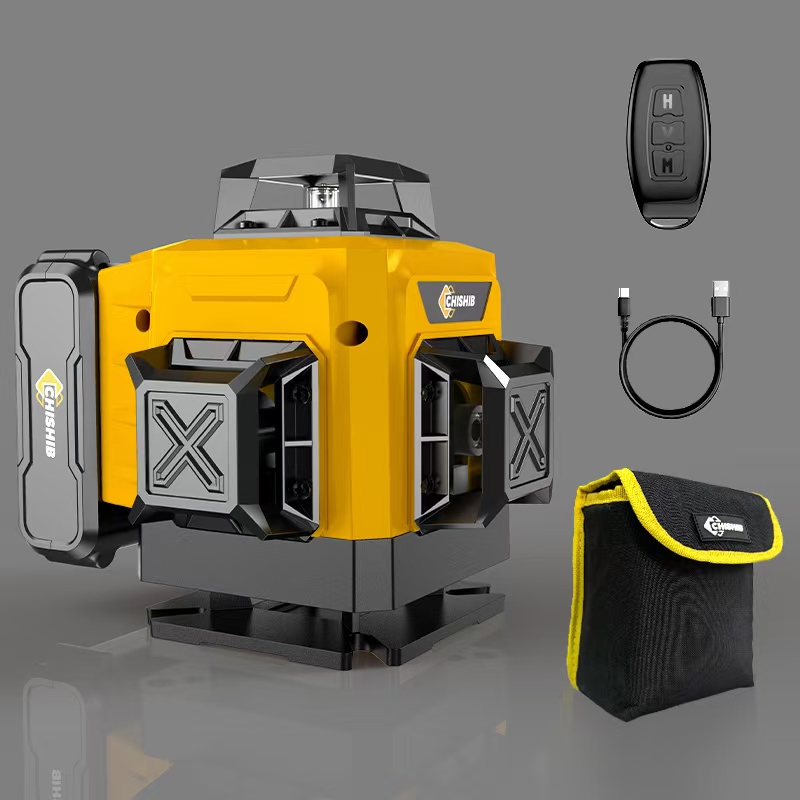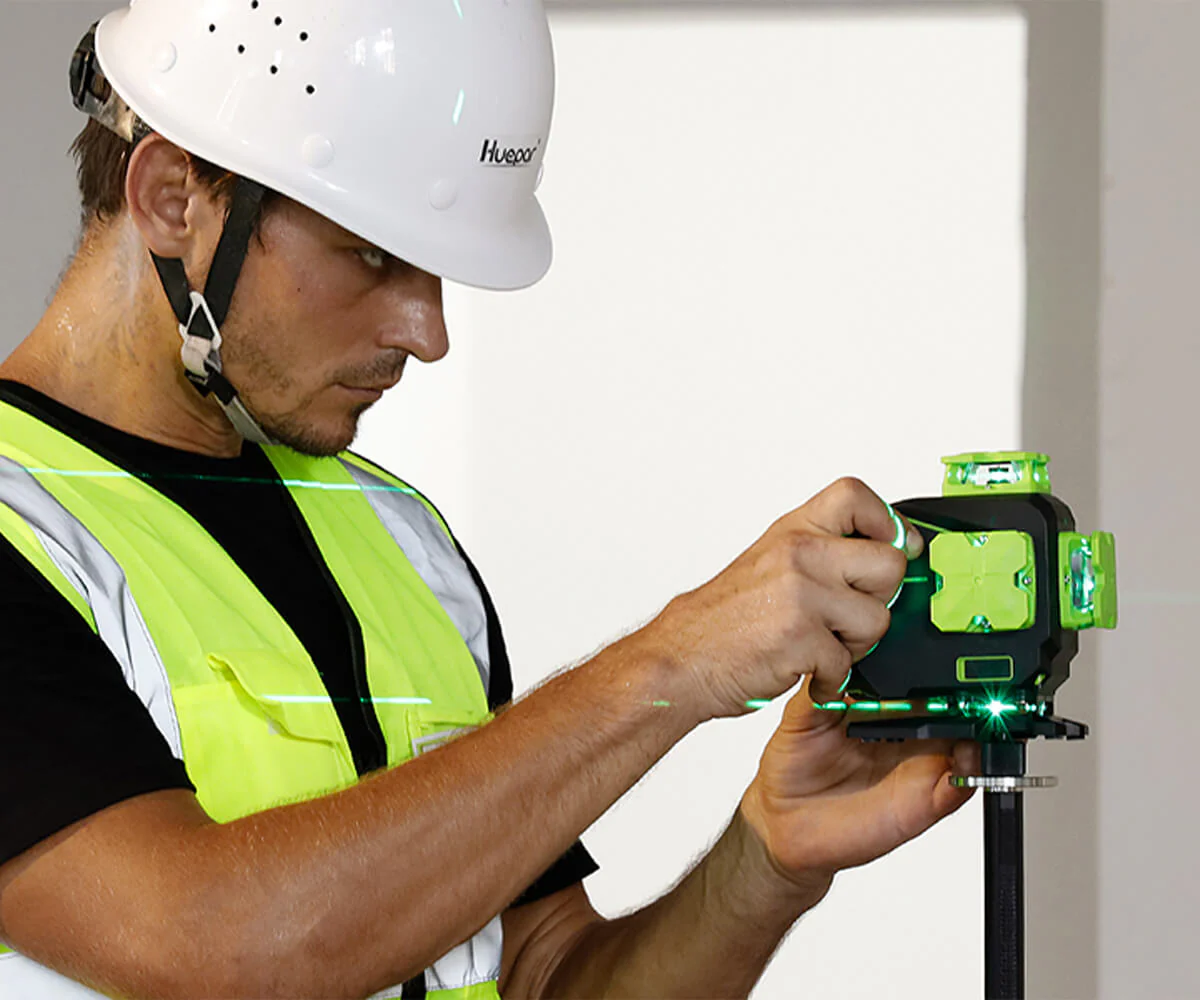
Share
Unlocking Precision: A Comprehensive Guide to 4D Laser Levels
March 12, 2024
Understanding the Basics of Laser Levels
What is a Laser Level?
A laser level is a device that emits a straight, level laser line onto a surface. It helps ensure accuracy in projects where straight lines are crucial. With its highly visible laser beam, it creates a ‘chalk line’ without the mess. This tool is vital for jobs that require precise alignment, such as hanging pictures, tiling, or setting up fences. Laser levels range from simple indoor models to robust ones fit for outdoor use. They are a must-have for do-it-yourself enthusiasts and pros alike.
Types of Laser Levels: From Dot Lasers to Line and Rotary Lasers
- Dot Lasers: Emit single or multiple dots for simple leveling tasks.
- Line Lasers: Project horizontal, vertical, or cross lines onto surfaces.
- Rotary Lasers: Cast a rotating level line 360 degrees around the room.
- Combination Lasers: Incorporate features of line and dot lasers for varied applications.
- 4D Laser Levels: Create three-dimensional reference points for complex layouts.
Understanding the types of laser levels is crucial for making the right choice for your project. Each serves a different purpose, with some offering basic functionality and others providing advanced features. For example, dot lasers are great for simple, quick alignments, whereas 3d laser levels are essential for complex tasks that require precise, multidimensional measurements.
The Advancements: 4D Vs. Traditional Laser Levels
The world of laser levels has greatly advanced with the entry of 3D technology. Unlike traditional laser levels that often project a single line or dot, 3d laser levels can project lines along the X, Y, and Z axes simultaneously. This provides a three-dimensional layout, offering a comprehensive view of the work area. With the ability to give clear, visible lines on all planes, the accuracy in tasks such as installing cabinets, tiling, or framing is significantly improved. The traditional levels are still widely used for simpler tasks, but when precision is key, especially in complex projects or when working around multiple angles, 4D laser levels are the preferred choice. The advancements in 4D laser level technology have paved the way for increased efficiency and precision in construction and renovation projects.
Exploring 4D Laser Levels
How Do 4D Laser Levels Work?
4d laser levels are advanced tools in the leveling world. They project four planes: horizontal and two vertical. This forms a ‘crosshair’ on a wall or object. The device emits beams using diodes. Systems inside the level keep the beams straight. Even when moved, the lines remain accurate. They use electronics to auto-level within a few seconds. Some models connect to apps for even better control. This tech helps with jobs that need precision like tiling or framing.
Applications of 4D Laser Levels in Construction and Renovation
4d laser levels are a game changer in building and remodeling. They offer ways to swiftly and precisely set out designs. This tech finds use in many tasks. Here are a few:
- Aligning and Plumbing Walls – Ensures walls are straight and true.
- Installing Drop Ceilings – Aids in maintaining level lines.
- Alignment of Pipes and Cables – Helps in guiding the installation process.
- Flooring and Tile Work – Assures a flat, even surface.
- Kitchen Cabinets Installation – Helps keep cabinets level and even.
These tools save time and cut mistakes. They are vital for modern construction work. They help teams work better and deliver top-notch results. Using 3d laser levels is now a must for pros in this field.
The Benefits of Using 4D Laser Levels for Accurate Measurements
4d laser levels boost both speed and accuracy in projects. Here are key benefits:
- Precision: They project lines in all three dimensions, lowering error chances.
- Efficiency: With all lines visible at once, they save time in setup and measuring.
- Ease of Use: Simple to operate, even for beginners, which reduces training time.
- Versatility: Ideal for a range of tasks like aligning tiles, cabinetry, and fixtures.
- Consistency: Users get consistent results on every project due to stable calibration.
Whether it’s a small home renovation or a large construction site, the use of 4d laser levels ensures measurements are spot-on. This precision tool is becoming a staple for professionals seeking reliable and repeatable accuracy.
Choosing the Right Laser Level
Cross Line Compared to 4D Laser Levels: When to Use Each?
Choosing between cross line and 4d laser levels depends on the task. Use cross line lasers for basic home projects like hanging pictures. They cast straight horizontal and vertical lines. For complex jobs in construction, go for 4D laser levels. They create a 360-degree plane, making them perfect for layout work. Also, use 4D types for installing cabinets and detailed carpentry. They ensure precision in every angle. So, pick what suits your project’s needs.
Key Features to Look For in a 4D Laser Level
- Self-Leveling Capability: The most crucial feature to seek is self-leveling. It ensures high accuracy without manual adjustments.
- Beam Visibility: Look for a laser with bright, clear beams, which are easier to see, even in well-lit conditions.
- Battery Life: Long battery life is key. This avoids constant recharging or battery swaps on the job.
- Durability: A sturdy design that withstands drops and harsh work conditions is essential. Look for models with a high drop rating and IP protection.
- Multiple Lines and Planes: More lines and planes mean more uses. Some models project lines in 360 degrees, both horizontally and vertically.
- Mounting Options: A good 4D laser level should offer versatile mounting options. This includes tripods, wall mounts, or magnetic brackets.
- Range and Accuracy: Check the level’s effective range and its accuracy over distance. It should align with your most common project sizes.
- Ease of Use: User-friendly interfaces and clear instructions make work faster and reduce the chance for error.
Understanding 4D Laser Levels: The Next Dimension in Precision
As technology advances, laser levels have evolved too. 4D laser levels are at the forefront. They cast lines in all directions. This makes leveling tasks quicker and easier. Imagine setting up a grid in your room with just one tool. That’s what a 4D laser level does. It offers lines on floors, walls, and ceilings all at once. For jobs needing precise work from every angle, 4D is the way to go. It can be a game changer for many projects. These projects range from complex layouts to simple home DIY tasks.

